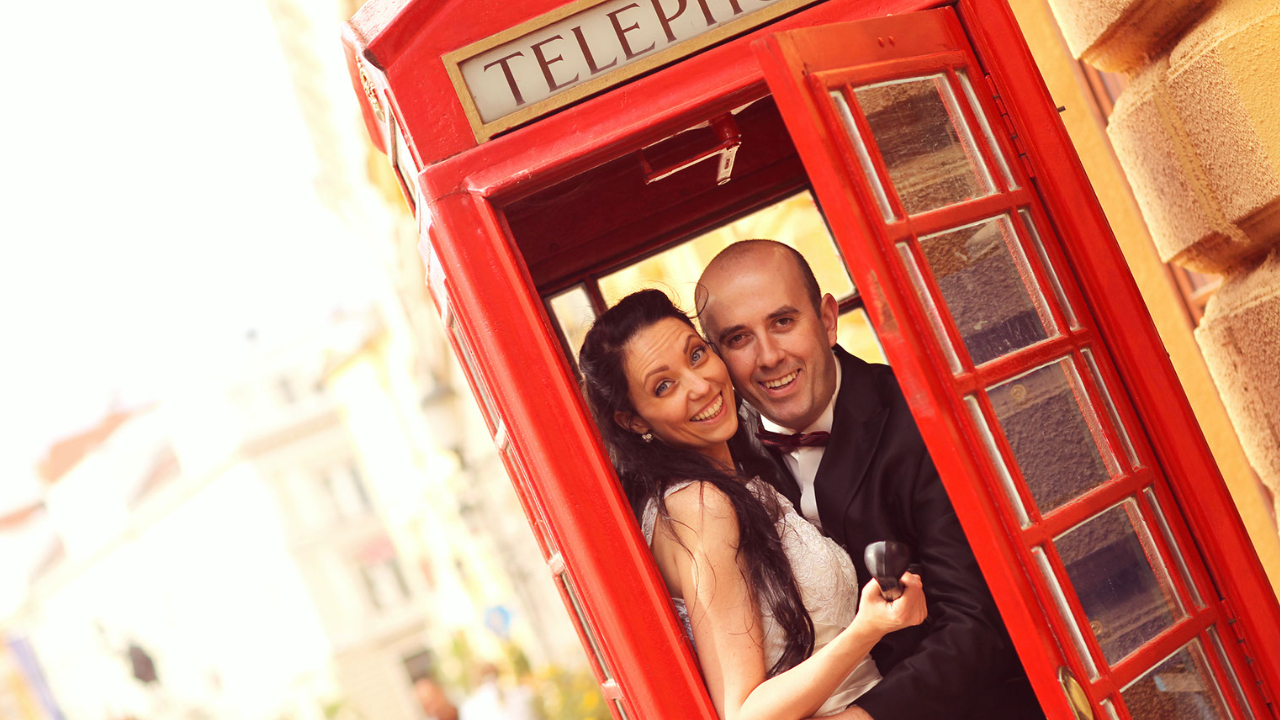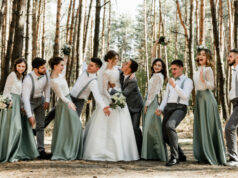Weddings are a universal celebration of love and unity, a ceremony that transcends cultures and borders. Despite this commonality, each region, country, and even town has its unique traditions and customs that contribute to the richness of the occasion. Europe, with its diverse cultures, languages, and histories, offers a fascinating study of these cultural nuances in wedding ceremonies. Let’s explore some of these traditions across a few European countries.
Note: the traditions detailed below are only those that can be found in the country indicated, and do not necessarily appear in every ceremony, as practices are modernized. Enjoy your reading!
▶️ Read also : Tips to save on your European wedding
The elegance of tradition and modernity: United Kingdom
Weddings in the United Kingdom offer a unique blend of age-old traditions fused with modern sensibilities. Undoubtedly, the most internationally influential is the white wedding gown, popularized by Queen Victoria. British weddings are also known for the charming custom that is recited as « something old, something new, something borrowed, something blue », symbolizing continuity, future prosperity, borrowed happiness, and fidelity.
The tradition of the tiered wedding fruitcake, with the topmost preserved for the christening of the firstborn, seamlessly merges joyous occasions, an embodiment of the continuity of life. Transitioning from the anglophone world, let’s head to the romantic country of France.
The epitome of elegance: France
One of the most delightful customs in France is the « trousseau, » an old tradition where the bride adds items to her hope chest, preparing for her future home. This originated from a time when young women gathered household items in anticipation of marriage. Today, it signifies the bride’s readiness for marriage and homemaking.
After the wedding ceremony comes the reception, which usually starts with a cocktail hour, « Le Vin d’honneur. » This is a unique French tradition where the couple can invite a larger circle of friends, colleagues, and acquaintances, outside of the main wedding party. It allows the newlyweds to greet their guests, many of whom will leave after the cocktail hour, with only close family and friends staying for the dinner reception.
The French also have a unique take on the wedding cake, traditionally known as « La pièce montée ». The most common form is the « Croquembouche », a tower of cream-filled choux pastry balls decorated with spun sugar. In some regions, a « Sarmentine », a cake shaped and decorated to look like a grapevine, is preferred. As we depart from France, let’s turn our attention to the vibrant charm of Italy.
▶️ Read also : Legal considerations for getting married in France

Vitality and luck: Italy
Italian weddings, steeped in rich traditions and rituals, are celebrated with an infectious joy that’s uniquely Italian. Starting with « La Serenata, » the pre-wedding serenade where the groom expresses his love under the bride’s window, the couple’s journey to matrimony is set in motion. On the wedding day, the bride carries « La Borsa, » a satin bag for guests to contribute envelopes of money, helping to offset the wedding expenses. These practices deeply resonate with the Italian values of love, community, and support.
The reception, known as « La Festa, » is a pivotal part of Italian weddings. The traditional Italian wedding feast often includes several courses with dishes signifying prosperity, fertility, and luck. The communal dance, « La Tarantella, » or the dance of love, adds to the reception’s vitality. Guests join in pairs or small groups, led by the couple, in this lively dance believed to ward off evil and bring good luck. Lastly, guests receive « Bomboniere », favors containing an odd number of sugar-coated almonds or « Confetti, » symbolizing the sweet and bitter aspects of marriage. These customs infuse the celebration with an enduring sense of joy, community, and a nod to time-honored traditions.

Let’s now journey north, to the heart of Europe and the fun-filled traditions of Germany.
Merriment and challenges: Germany
German weddings offer a delightful blend of customs and playful challenges, adding a unique dimension to the couple’s journey into matrimony. A notable pre-wedding tradition is « Polterabend », where family and friends gather to break porcelain dishes for good luck. This boisterous event often involves music, food, and drink, reinforcing the sense of community and shared joy. During the wedding ceremony, it’s customary for the bride to carry salt and bread in her pocket, symbolizing prosperity, while the groom carries grain for wealth and good fortune.
The wedding reception is marked by the traditional « Baumstamm sägen », a fun and symbolic custom where the newlyweds saw a log in half in front of their guests. This challenge symbolizes the first obstacle that the couple must overcome in their married life, emphasizing teamwork, cooperation, and shared effort. Another interesting tradition is the bridal kidnapping or « Brautentführung », where the bride is ‘kidnapped’ by friends and taken to a local pub, and the groom must find her, demonstrating his commitment and love. These customs inject a unique sense of fun and symbolism into German weddings, encapsulating the essence of unity, teamwork, and the joy of shared experiences.
From the lively customs of Germany, we travel south to the passionate realm of Spain.
Passionate symbolism: Spain
Spanish weddings are marked by their vibrancy, symbolism, and deeply rooted cultural traditions. The matrimonial journey begins with the « Pedida de mano », or the proposal, where the groom formally asks for the bride’s hand from her parents. During the ceremony, the couple exchanges « Arras » or 13 coins, which the groom gives to the bride in a small box. This poignant moment symbolizes the groom’s promise to provide for his family and trust in the bride with their finances.
The reception of a Spanish wedding encapsulates the spirit of celebration and community. Traditional Spanish music and dance play a significant role, with the « Sevillanas », a flamboyant Andalusian dance, being a highlight of the evening. As the rhythm picks up, guests join the couple on the dance floor, adding to the dynamic atmosphere. In terms of cuisine, a Spanish wedding feast is renowned for its variety and flavor, often including regional specialties and the well-loved Paella. Finally, it’s customary for the bride to hand out small pins, or « detalles », to unmarried female guests to bring them luck in finding a partner. These traditions infuse Spanish weddings with a unique blend of passion, rhythm, and communal joy.
Moving eastwards, we encounter the deep-rooted Orthodox traditions of Greece.
Sacred unions: Greece
Greek weddings are celebrated with Orthodox Christian rituals. They are filled with deep symbolism and time-honored rituals that have been passed down through generations. The preparation begins with « the making of the marital bed », where relatives and friends come together to make the bed and throw money and rice for fertility and prosperity. On the wedding day, the couple participates in the « crowning ceremony », or « Stefana », where they are joined by a crown, or « Stefano », linked by a single ribbon symbolizing unity and shared responsibility in their marriage.

Greek wedding receptions are lively events filled with music, dance, and feasting. The traditional first dance of the couple, known as the « Isaia », is accompanied by the song « Isaia Horeve », wishing the bride a happy life. The « money dance » or « Kalamatiano » is a common sight, where guests pin money on the bride’s gown or the groom’s suit to contribute to their new life together. As for the cuisine, a Greek wedding feast is a gastronomical delight with dishes such as « Moussaka » and « Baklava », representing the country’s rich culinary tradition. These customs add to the vibrancy and communal spirit of Greek weddings, celebrating not just the union of two individuals, but also the coming together of families and friends.
Next, we explore the warmth and lively festivities of Poland.
Festive continuity: Poland
Known for their exuberance, Polish weddings can often last two days. The « Oczepiny » ceremony is one of the oldest traditions, marking the bride’s transition from maidenhood to married life. Alongside this, the tradition of « Wódka and Pickles » with shots of vodka followed by a pickle are common, adding a unique flavor to the celebration.
Now, let’s journey to the grandeur of Russian weddings.
Playful grandeur: Russia
Russian weddings are often grand affairs, sometimes lasting up to a week. One notable custom is the playful « Ransom for the Bride », where the groom and the bride’s family negotiate a symbolic price. The couple’s shared wedding sweetbread, « Karavay », signifies prosperity and blessings, ensuring the ceremony ends on a sweet note.
Harmony with nature: Sweden
Swedish weddings beautifully encapsulate the country’s love for nature and simplicity. One of the most charming customs is the tradition of the bride walking down the aisle with a silver coin from her father and a gold coin from her mother in her shoes. This custom symbolizes the parents’ wishes for financial prosperity for the couple. The ceremony often takes place outdoors, in harmony with nature, reflecting the Swedes’ profound connection with their natural environment. Flowers play a significant role, not just in decorations, but also woven into the bride’s hair, symbolizing fertility and love.
As we soak in the serene Swedish customs, let’s journey south to the lively and warm climes of Portugal.
Symbolic rituals and vibrancy: Portugal
Portuguese weddings are full of color, vibrancy, and symbolic rituals. An interesting custom is the bride and groom walking down the aisle together, rather than the groom waiting at the altar. This act signifies their journey as equals. Following the ceremony, it’s customary for guests to shower the newlyweds with handfuls of grain, a symbol of fertility and prosperity. A unique and heartwarming tradition is the bride’s dance with all the male guests; they donate money for the couple’s honeymoon or their new life together. This dance, often called the « money dance », signifies the community’s support for the couple’s new chapter.
These examples underline the rich and varied cultural nuances in European wedding traditions. Despite the differing practices, every country shares the universal ethos of celebration, the union of two individuals and their families, and the community’s good wishes for the newlyweds’ future.






